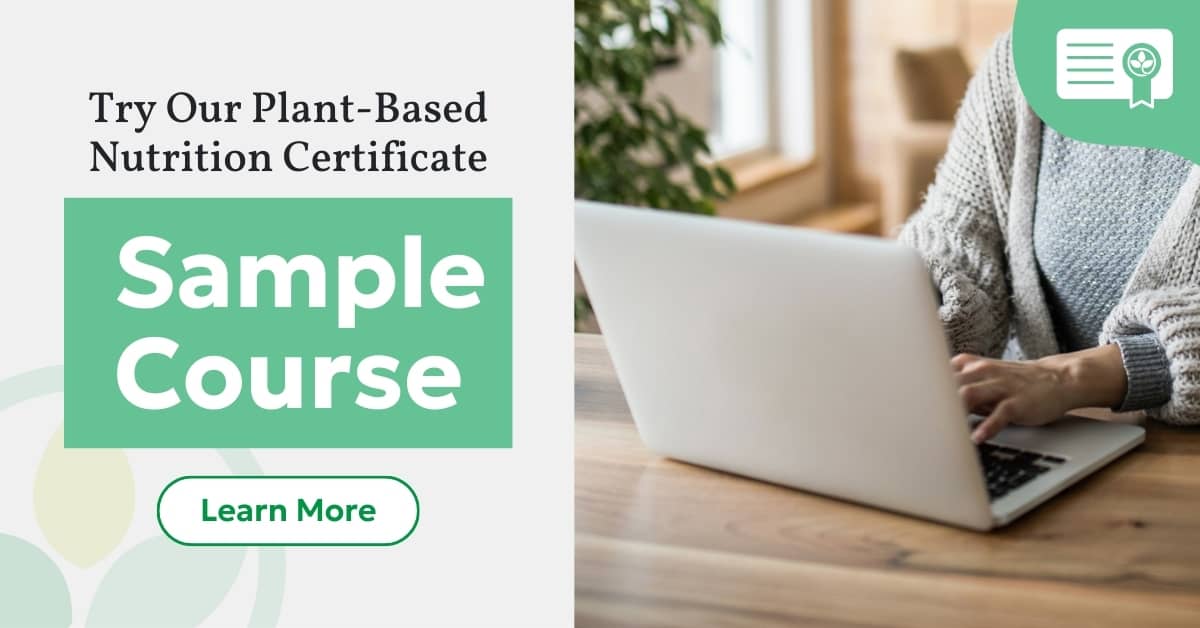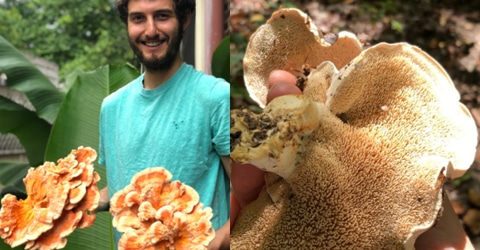

The Center for Nutrition Studies (CNS) and its authors are not foraging experts; CNS does not promote the consumption of specific wild foods in nature. This foraging series shows the abundance of food in the natural world. Please use caution when eating anything growing in nature.
As you might remember from your Foraging 101 class in college, there are a few things to keep in mind while looking for plants and mushrooms in the wild. What’s that? You didn’t take a Foraging 101 class in college? Do you mean to tell me they don’t teach a beginner class on foraging at any point in the US education system? I’m shocked! Next you’ll try and tell me they don’t teach about plant-based nutrition in medical school…
All joking aside, as you embark on this journey, know that it takes time to master the foraging craft. Luckily, you don’t need to be an expert to begin foraging safely. However, there are some guidelines to follow and some communities that you will want to connect with. This list is not exhaustive. Because I cannot possibly convey everything you need to know about foraging in a single article, the Center for Nutrition Studies has created an online Facebook community where discussing and guidance on foraging is welcome.
How to Start Foraging
The first two steps to start foraging are:
- Do not eat anything you have not positively identified.
- Go slowly: observe, research, taste, wait, then eat.
There is no rush to eat every single mushroom and plant in the forest. First, start by identifying plants and mushrooms without eating them. Research the plant or mushroom thoroughly. Does it have any lookalikes? If so, what are the defining features that separate the two? Post some photos to online groups and ask if they can confirm or deny your best guess. Start with plants that are easy to identify and that are not known to produce allergic interactions.
Did you know that you can make tea out of pine needles and you can eat these colorful catkins?
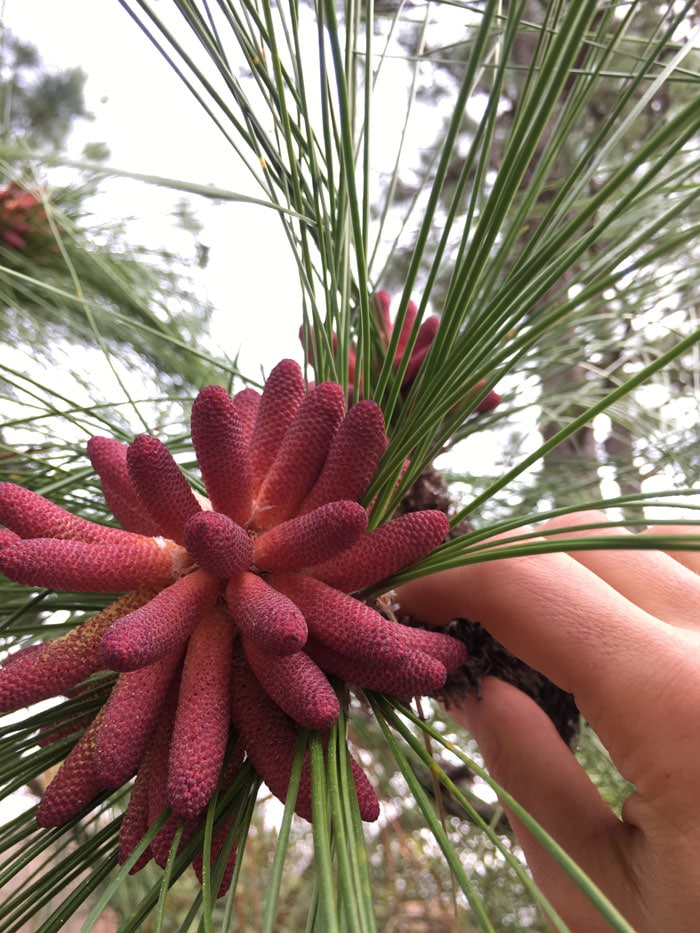
Did you know that you can eat the flowers of a redbud tree?
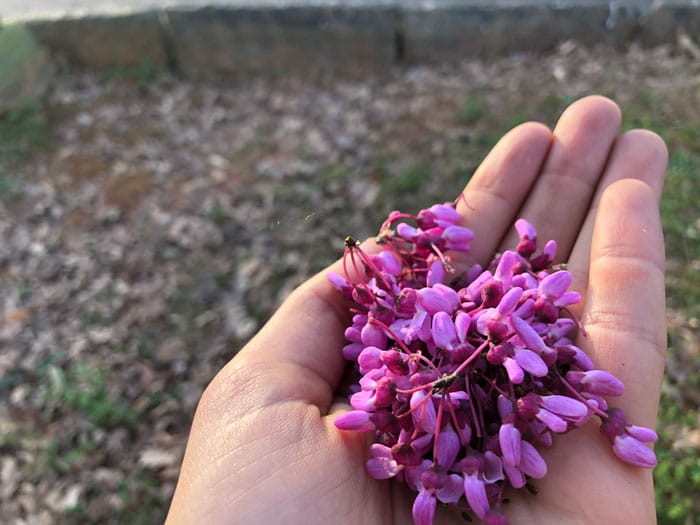
This is a white variant of the redbud tree, and the flowers are still delicious! Notice how the flowers grow on the trunk and branches. The Latin term to describe this type of growth is cauliflory. This will help you distinguish between this plant’s beautiful pink (or white) flowers and other similar-looking plants that have flowers coming off of the end of their branches.
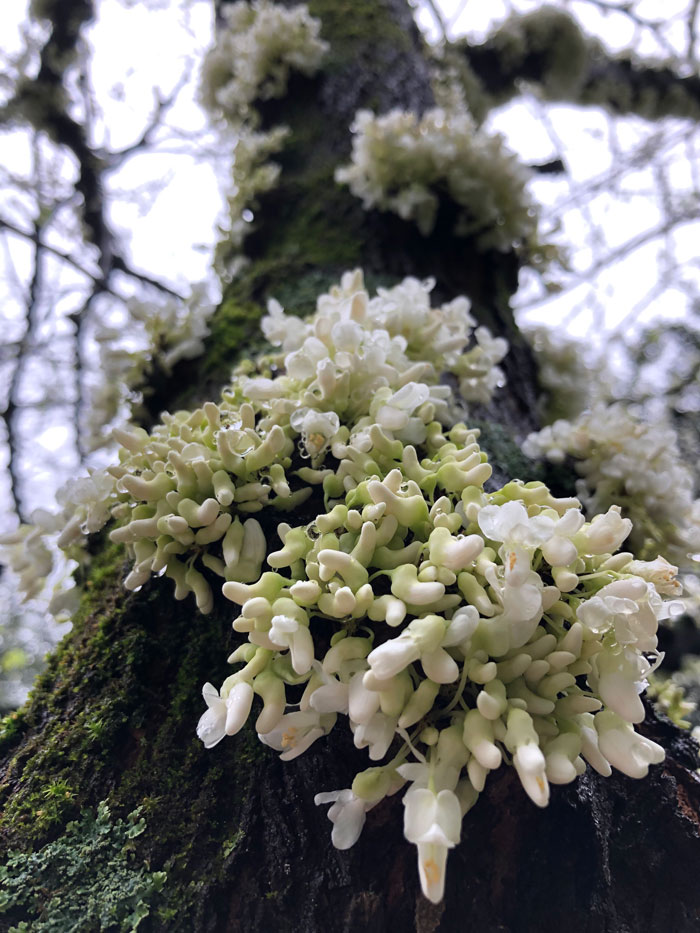
The heart-shaped leaf of the redbud combined with flowers growing from the trunk and branches are a dead giveaway of this tasty treat.
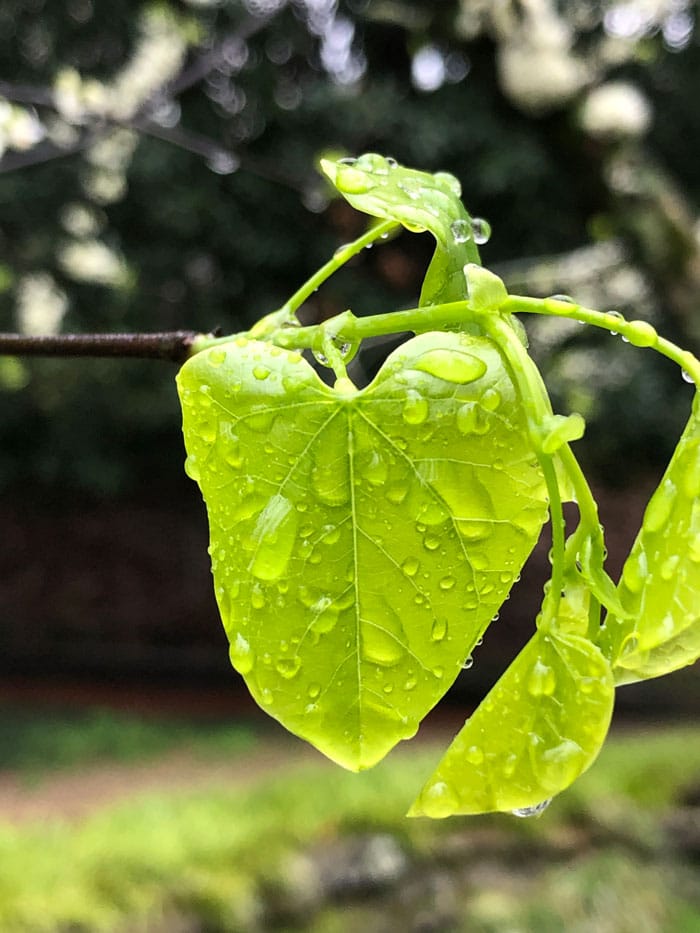
Have you ever picked wild blueberries? Here are acres and acres of blueberries in North Carolina! These plants are difficult to mistake.
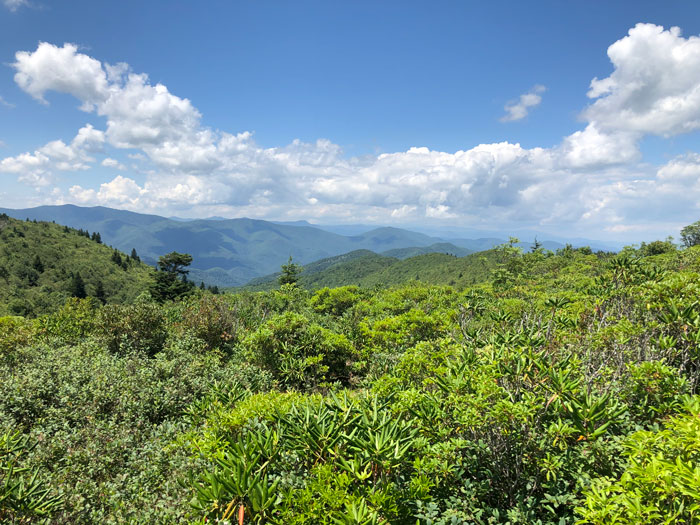
As with any new food, you may have an allergic reaction. For this reason, it is recommended that you start slow. Consider taking a single bite of a cooked mushroom or a small amount of the plant, fruit, flower, nut, etc., to see how you react. Wait a day and then try a bit more if you had no reaction. Be sure to research how much of the plant or mushroom is commonly consumed. Just as you wouldn’t make a meal out of garlic or clove, for example, there are some plants or mushrooms that are best enjoyed in smaller quantities and others that can be eaten in bulk.
The other three steps to start foraging involve arriving at a positive ID, often by connecting with experts:
- Connect with experts locally and online.
- Contact your local nature center and reach out to a naturalist
- Reach out to a local university or an extension office
- Look for local forages or hikes from local groups (post-COVID)
- Ask your experts to teach you about local wildlife and how to identify the flora and fauna
- Take a naturalist certification program
- Join the Food and Sustainability Facebook group
- Check out The Mushroom Identification Forum
- Check out community forums like Reddit
- Check out Learn Your Land educational videos
- Search Facebook for “{Your State} Mushroom” or “{Your State} Foraging/Plant ID” and see what comes up. Chances are there is a group for your state with experts and novices posting photos of their recent forages
- Although few people will affirmatively call themselves experts in mushroom foraging groups, to find an online expert, join a few different mushroom or plant groups. The same people tend to post in many different groups and they are often the same people correctly identifying mushrooms and plants. Read through the comments on as many different posts as you can and you’ll start to notice the true experts. Ask them about their training to learn more about them and whether you would trust their IDs
Local
Online
- Read identification guides written by experts, such as:
- Nature’s Garden and Forager’s Harvest, both by Samuel Thayer, Eastern US
- Mushrooms of the South East by Todd Elliot and Steven Stephenson
- Southeast Foraging by Chris Bennett
- Native Trees of Georgia from the Georgia Forestry Commission
- Know the land and forage with conservation in mind
Also always make sure you are foraging in a location where it is legal to do so. These laws are often arbitrary, varying from county to county, and state to state. Often, national parks ban foraging (with exceptions) while national forests tend to allow the practice. Wilderness management areas are often open for foraging for personal use with a license. The reason for these laws is ostensibly conservation, yet foraging expert Samuel Thayer disagrees:
Somehow, the complete elimination of wild lilies from tens of thousands of acres through grazing is acceptable, but for me to dig up enough of them for a meal is a crime. I don’t think they are really afraid that too many foragers would harm the environment. I think they know that “too many” of us will force them to protect it.
This quote supports my assertion in 5 Reasons to Forage for Plant-Based Food, where I hypothesize that more foragers will actually increase my bounty and opportunity to forage. The more my neighbors know about foraging and nature’s garden, the harder they will fight to preserve nature so that we can continue to enjoy wild foods. Thayer encourages us to explore the duality of exploitation and protection, to find a middle ground that will allow us to feed ourselves, our families, and our communities.
In a more prescriptive tone, Thayer encourages beginner foragers to survey the land and respect what the land has to offer. For plant foraging, take only from plants that grow plentifully in the area, and don’t take more than the remaining population can replace. Harvesting plants requires knowledge of each plant, how it reproduces, and how it thrives. Learn more about the plant in question to know how you can harvest it sustainably. For mushroom foraging, most foragers equate picking a mushroom to picking fruit. Mushrooms exist as mycelium inside the earth and inside trees. When the mushroom begins to “fruit,” it produces a visible fungus. By picking its fruit, you do not harm the mycelial network. There has been debate over whether to cut the mushroom or whether to pick the mushroom. Research suggests that pulling the mushroom might actually improve growth, whereas cutting the mushroom seems to have no significant impact on future fungal growth.
Jumping into the world of foraging is often both exciting and anxiety-provoking. The best way to quell anxiety about poisoning yourself is to learn as much as you can about anything you intend to eat.
Jumping into the world of foraging is often both exciting and anxiety-provoking. The best way to quell anxiety about poisoning yourself is to learn as much as you can about anything you intend to eat. Just as someone might learn common words when learning a new language, beginner foragers should survey the land around them. What are the common trees and mushrooms in your area? Take photos and post them on our Facebook group. I will personally let you know if I can identify your tree or mushroom, provide my degree of certainty, and give an explanation as to why the mushroom or plant is what I say it is. I’m not an expert in every mushroom and every plant. For that reason, I ask foragers, naturalists, botanists, and mycologists along with any other nature lovers to join us in discussion as we discover nature’s garden, together!
Copyright 2025 Center for Nutrition Studies. All rights reserved.
Deepen Your Knowledge With Our
Plant-Based Nutrition
Certificate
Plant-Based Nutrition Certificate
- 23,000+ students
- 100% online, learn at your own pace
- No prerequisites
- Continuing education credits

